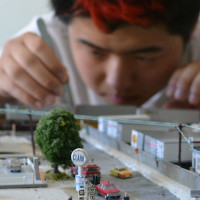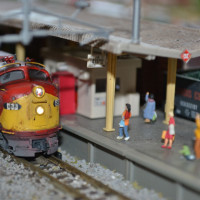
Everyone has a favorite hobby, whether it is drawing, writing, or stamp collecting. For senior Alvin Ho, his passion is modeling. Not the Vanity Fair or Hugh Hefner kind, though: Ho makes models of anything ranging from airplanes to trains. A member of the Aragon Robotics Team, Math Club, and an avid violin player, Ho manages to fit modeling into his schedule.
Ho started his hobby in elementary school. Before making trains, he modeled other, simpler things. “I originally started with military vehicles—tanks, planes, and whatnot—but these were all kind of boring, because, you know, they don’t move. My first [train] set was just like Thomas the Tank Engine; I didn’t have to put it together or anything.”
Unsatisfied with Thomas, Ho started focusing on the more intricate aspects of model making. He became more involved with the finer details of the modeling process, going for “prototypical fidelity” or the model’s accuracy when compared to the real thing. To achieve this accuracy, Ho combines parts from different model sets to make custom trains. Eventually, he became more serious about his work. He says, “About four years ago, I joined the NMRA—the National Model Railroad Association—and got involved with them. I got to see the great work that other people were putting out.”
Ho was inspired by seeing others’ work. He says, “It’s awesome meeting up with people who like to do the same stuff. I get advice from some [people] and help other[s]. I went to this event hosted by the Silicon Valley Free-moN, a modeling group, and when I first went I saw people with their entire layout—local people—and I was like, ‘Man that’s cool.’”
Ho’s tinkering with trains, despite requiring an incredible amount of patience and attention to detail, still remains an enjoyable hobby. “It’s sort of a de-stressor, but for magazine models it can get stressful because then you have to meet deadlines,” Ho admits. “With your own time though, it is definitely relaxing, like, ‘Oh, I can add some detail today, or airbrush something.’”
The intricacies of the model trains may seem inane to some at first. Ho explains, “Every train comes with a story, and that’s why it has certain details. Like, if a company is going bankrupt [at the time], it’s going to be obvious from rust streaks and chipped paint or mismatched parts.” For his work in detail, Ho won an award at an NMRA competition. “I got the special award for Best Finish, which means you match not just the detail but the paint and numbers and everything,” he says. “I replicate the very rough finish, like oil, rust, and dust, from trying to match it as closely to the picture as I can—again, prototypical fidelity.”
Ho was approached by a representative from the magazine Railroad Model Craftsmen to write an article about his methods and work, including his custom models. He notes, “Currently, I’m on their homepage. It feels really great to be able to write and share with the modeling community. It’s pride in your own work and being able to share what you know and learn from other people’s technique at the same time.” He adds, “A lot of the painting stuff I learned [from the magazine]. I wasn’t really into the whole airbrushing thing—it’s really hard, and there’s a lot of technique to it—so I learned a lot and modified it and made it my own.”
Ho has a rather famous “train room,” which is the home of his extensive layout. Senior David Koshy says, “It’s unique because no one else has anything like it. It’s a unique hobby and he excels at it. If you look at the set, everything is meticulously made.”
Ho notes, “I’ve had the room from the beginning. We had this extra room, so I asked my parents if I could use it, and they said sure. At first it was a simple loop of track, but now it’s definitely more expansive.” The layout features an impressive amount of detail, from the scenery to the trains themselves. “When you’re taking pictures and trying to make a scene, the idea of it is to make it as real as possible, so you try to match it to its real habitat,” he says.
As a senior, Ho made it through the rigorous application process to universities across the country, deciding on Northeastern University with a major in Mechanical Engineering. He admits, “I think the modeling influenced my choice in major. It was definitely that and Robotics, too, obviously.” For anyone trying to improve a skill, Ho says, “It might be difficult to start out at first, but do what you love and love what you do, and you’ll get better. It’s like the quote, ‘Perfection is not attainable, but if we chase perfection, we can catch excellence.’ So you go above and beyond and end up with something great.”






